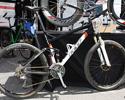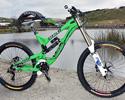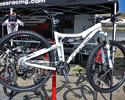
Recently on Cyclingnews.com |
Sea Otter Classic Expo
Monterey, California, USA, April 16-19, 2009
Part 1 - April 16: Sea Otter Classic expo opens to sunny skies
By James Huang in Monterey, California
Felt developing 4"-travel cross-country race bike

|
Felt Bicycles’ head suspension engineer Mike Ducharme was seen rolling around the Sea Otter venue aboard a prototype aluminum full-suspension test mule that was developed especially for the company's sponsored athletes - such as the Mafia Racing team - in order to give them something more cross-country race-appropriate than the current Virtue trail bike.
The unnamed prototype sports 4" of travel versus the Virtue's 5" and also a snappier pedaling response thanks to a re-tuned Equilink suspension design. The carbon fiber seat stay/dropout/chain stay assemblies were molded in one piece as on the Virtue 1 and Felt also machined upper and lower linkages and a new Equilink specifically for the project.
According to Ducharme, a large frame weighs about 5.9lb while a complete race-ready rig can be built to sub-22lb.
Ducharme says this short-travel platform was built mainly as a development project just for the teams though, and isn't likely to make it to production. Instead, Felt will ultimately offer a more advanced-level cross-country bike that is "a little bit different" - probably in carbon and certainly lighter - and the final product may not even use the Equilink suspension design.
Unfortunately we'll have to continue to wait to see what comes about but it's at least good to know that something is on the way.
Intense Cycles’ new 951 DH bike

|
Intense Cycles showed off its new 951 at this year’s Sea Otter Classic. The dedicated downhill racing platform features 8-8.5" of rear wheel travel, second-generation VPP linkage geometry, a 1.5" head tube, proprietary Easton EA6 aluminum tubing and a machined 83mm-wide bottom bracket shell with integrated ISCG05 tabs and lower linkage pivot.
The top-end FRO model will be built with a monocoque top tube and down tube and will also include adjustable rear dropouts for customisable wheelbase, bottom bracket height and head tube angle. Claimed weight is approximately 9.5lb with the included Fox Racing Shox DHX RC4 rear shock.
The standard version will use more conventional tubing throughout, omits the adjustable rear dropouts, and will come with a Fox DHX RC2 rear shock.
Both frames will be offered in six colors - including the works 'raw' finish for true weight weenie types - and three sizes. The 951 FRO will cost about US$2700 and is scheduled for delivery starting around the end of May while the standard 951 will be US$2400 and will arrive later in the summer.
Tomac debuts lighter Carbide SL

|
Tomac Mountain Bikes jumps headfirst into the ultralight cross-country world with its new Carbide SL. The new frame sports just 90mm of rear wheel travel but also weighs just under 2kg (4.4lb) in a large size including a DT Swiss rear shock mostly thanks to a new carbon fiber rear swingarm.
Even with the Carbide SL’s low weight, Tomac still place a high priority on durability. Dropouts and suspension hard points are aluminum and the single-pivot swingarm design features just three sets of bearings (the rear swingarm flexes about three degrees through the compression stroke to accommodate geometry changes).
An 80mm fork yields quick 71/73 head/seat tube angles while a 100mm fork relaxes things a half degree. Tomac will offer the Carbide SL in four sizes and retail price is approximately US$2700 for the frame and fork.
Foes does 29"

|
Foes Racing displayed a prototype 29" cross country frame with 100mm of rear wheel travel and its trademark 2:1 low leverage ratio suspension design. The single-pivot rear end included a tidy swing link up top plus a giant Curnutt air-sprung rear shock.
Claimed frame weight was not available nor was pricing or availability as the frame was still in development. Chalk up another one for the wagon wheel crowd regardless.
Tucked next to the 29" prototype was a super trick custom tricycle - apparently someone at Foes recently had a baby - complete with the Foes trademark monocoque aluminum construction, a dual crown fork, lathe-turned alloy wheels at all ends, and liberal doses of machining throughout.
Also on hand was a unusual-for-Foes urban commuter dubbed 'Pasadena' in homage to the company’s headquarters. The alloy frame bore the usual welded monocoque construction and was fitted with a variety of pavement-oriented bits: 700c wheels with skinny road tires, a carbon bladed fork, a carbon seatpost and taller gearing. Not what we usually expect to see from Foes but a nicely executed example of the genre nonetheless.
FSA launch Vision wheel range and new 2x9 cranksets

|
FSA launched a new range of aero wheels at this year's Sea Otter Classic under its Vision nameplate. As befitting the TT/Tri-specific Vision label, the four-model range will place a strong emphasis on aerodynamic performance.
The top-end Vision TriMax Ultimate uses an 88mm-deep carbon tubular rim, Sapim straight-pull bladed stainless steel spokes (20/24 front/rear) and cartridge hubs with ceramic bearings, interchangeable alloy freehub bodies and a carbon front hub shell.
The US$2000 asking price will include a pair of Vision Mercury skewers with stainless steel shafts and carbon levers, wheel bags, valve extenders, and a set of SwissStop Yellow King pads. Claimed weight is 1730g for the pair (without skewers).
Next in the range is the TriMax Carbon with 50mm-deep carbon tubular rims and the same spokes and hubs but with steel bearings instead of ceramic and without the carbon front hub shell. Claimed weight drops accordingly to a more versatile 1420g for the pair. As with the Ultimate, the Carbon’s US$1600 retail price will include Mercury carbon skewers, bags, valve extenders and SwissStop pads.
The TriMax Pro uses the same hubs as the Carbon but is intended more for training with its 30mm-deep aluminum clincher rims. Alloy skewers and rim tape are included for US$650.

|
Completing the range is the TriMax carbon tubular flat disc wheel with a 20.5mm width, interchangeable freehub bodies and threading for track cogs. Claimed weight is 1280g without the included carbon quick release skewer and suggested retail price is US$1700.
FSA also showed off their latest range of 2x9 mountain bike cranks which use a proprietary ‘386’ spider configuration (three bolts, 86mm bolt circle diameter) instead of the previous version’s 94m pattern. According to FSA, this allows for smaller and more versatile inner ring sizes than before and the new cranks will be fitted with 27/40T or 27/42T sizes.
FSA will offer the new cranks in K-Force Light carbon fiber and Afterburner hollow-forged aluminum varieties, both in either standard 68/73mm threaded or BB30 bottom bracket configurations. The K-Force Light model will include ceramic bearings as standard equipment, a slightly narrower 164mm pedal stance width, and a trick outer chainring with extra-thick sculpted mounting tabs that yield extra stiffness for improved shifting.
Claimed weight for the complete BB30-compatible version is around 680g and suggested retail pricing is right around $1 per gram. Given the roughly two-hour machining time per outer chainring, replacement costs will be pricey there as well at around US$200.
The Afterburner version will offer far better value at about US$270 and just over 700g in BB30 (MegaExo versions will still weigh under 800g). Pedal stance width is a more common 170mm or so and the outer chainring is made from conventional aluminum plate.
Both cranks will be available around the end of June.
Photography
For a thumbnail gallery of these images, click here
Images by James Huang/Cyclingnews.com
- Felt developed a short-travel cross-country bike just for their sponsored racers.
- The prototype test mule uses an Equilink suspension design similar to that of the 5" Virtue.
- The entire rear end is purpose-built for the 4" bike though and includes proprietary stays, upper and lower links, and the Equilink strut.
- Each side of the rear end is molded as one part including the rear dropouts. Felt engineer Mike Ducharme says that the bike ultimately may not end up using the Equilink setup in the end though.
- Intense Cycles debuted their new downhill bike at Sea Otter dubbed the 951.
- The new 951 will use second-generation VPP suspension geometry.
- Adjustable dropouts allow users to tweak the effective chain stay length, bottom bracket height and head tube angle.
- The machined bottom bracket shell integrates the ISCG05 tabs and lower suspension pivot.
- The 1.5" head tube can accept dual crown forks or the latest crop of burly single-crown models.
- The machined upper link has two shock positions for 8" or 8.5" of rear wheel travel.
- The lower link features grease fittings for easy maintenance.
- The hydroformed down tube flares at the bottom bracket for more rigidity.
- The top-end 951 FRO uses monocoque construction plus additional gussets up front for extra strength.
- The kinked seat tube includes a machined knuckle to mount the upper link.
- Aggressive machining saves a few grams.
- There is plenty of clearance for massive tires, too.
- Tomac's new Carbide SL enters into the superlight category with a sub-2kg weight.
- Most of the weight savings comes courtesy of the new carbon rear end.
- Tomac continue to use their reliable single-pivot suspension architecture for the new Carbide SL.
- The carbon-bodied DT Swiss shock keeps the weight down, too, while the welded upper linkage keeps the rear end in line.
- Tomac stick to aluminum for the dropouts and suspension hard points.
- The Carbide SL uses a conventional 1 1/8" non-tapered front end.
- Foes showed off a new 29" prototype.
- The 29" prototype uses Foes' trademark 2:1 leverage ratio and Curnutt air shock.
- Beefy machined rear dropouts decorate the rear end.
- A tidy gusset strengthens the front end.
- The 29" prototype sticks to Foes' tried-and-true single-pivot suspension design.
- Foes also displayed this Pasadena commuter.
- Though meant for getting around town, the Pasadena still uses Foes' trademark monocoque aluminum construction.
- Wow, it's good to be a kid in the Foes company family.
- This Foes trike includea a dual-crown fork for, um, extra stiffness?
- Words to live by.
- The basic cylindrical pedals rotate on sealed cartridge bearings.
- The saddle is even adjustable fore-aft.
- FSA launched a new line of Vision wheels at Sea Otter such as this 88mm-deep TriMax Ultimate.
- The top-end TriMax Ultimate uses a carbon-shelled front hub.
- The TriMax Carbon uses a 50mm-deep carbon tubular rim.
- The TriMax Carbon's hubs are mostly identical to those of the Ultimates save for steel bearings and an aluminum front hub shell.
- The rear hubs features six bearings, three hardened steel pawls, and oversized aluminum axles.
- The TriMax Pro is meant more for training with 30mm-deep aluminum clincher rims.
- Interchangeable alloy freehub bodies are available for SRAM, Shimano 9/10spd and Campagnolo 10/11spd drivetrains.
- Vision will also offer a full flat carbon disc rear wheel.
- The TriMax Disc can be used with multispeed…
- …or fixed-gear applications.
- The inner edges of the valve hole are nicely finished with a layer of carbon fiber.
- FSA also showed off a new 2x9-specific mountain bike crankset with a proprietary 3x86mm bolt circle diameter.
- The top-end K-Force Light version uses an extra-beefy outer ring that starts out as a 10mm-thick aluminum plate.
- Chainring bolts enter from the backside and thread directly into the outer ring.
- The Afterburner 2x9 is definitely a better value costing just over a third that of the K-Force Light and weighing less than 100g more.
- Yes, now you can even get headsets in white.
- For those of you who just have to have it, FSA offers a carbon bottle cage now, too.
